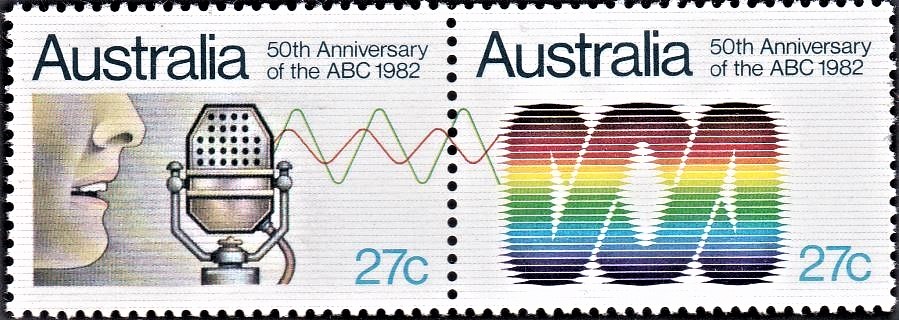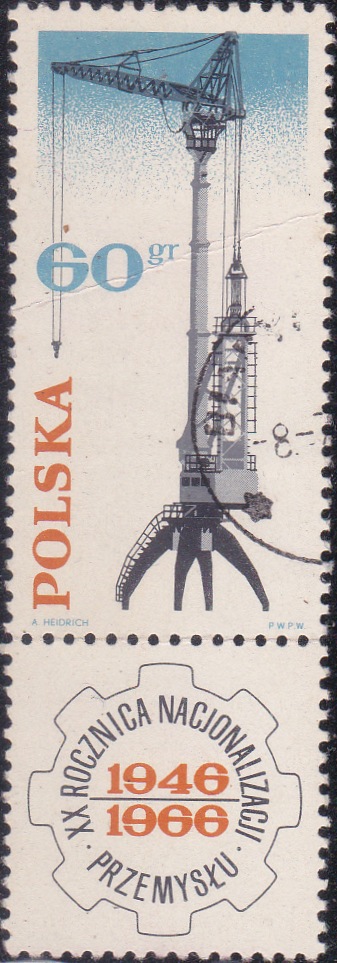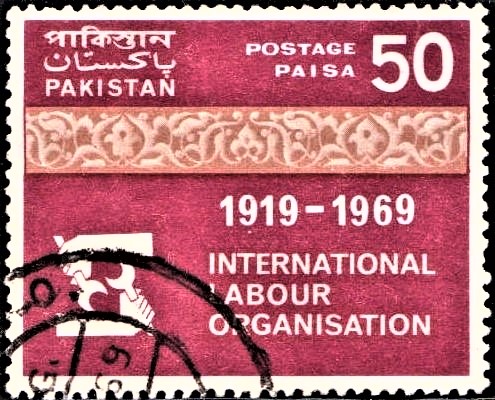
Australian Broadcasting Commission
Complete Set of 2 nos of postage stamps on the 50th Anniversary of the Australian Broadcasting Corporation (ABC), national broadcaster of Australia :

Issued by Australia
Issued on Jun 16, 1982
Issued for : To commemorate the 50th anniversary of the establishment of the Australian Broadcasting Commission, Australia Post issued a se-tenant pair of stamps on 16 June 1982.
Design : The microphone depicted in the stamp on the left is a graphic interpretation of the style of equipment used by the ABC during the 1930s, approximating in some respects the RCA 44 BX. Artistic licence has been invoked in the placement of the head of the announcer in profile; in practice the head would need to be turned directly towards the microphone to avoid the ‘dead area’. The ABC logo is especially recognisable to television viewers, although in a slightly different form from that shown on the stamp. The version of the logo depicted by Australia Post inadvertently shows a ‘mirror image’ of the official ABC symbol. The design of the logo is part of a wave form on an oscilloscope for measuring frequencies, and thus is relevant for both radio and television. The three loop wave form was chosen by the ABC as the most suitable to link in with the three letters.
Designer : Cato Hibberd [After graduating from the Royal Melbourne Institute of Technology, Mr Ken Cato served a brief apprenticeship with a design studio. In 1970 he met Mr Terry Hibberd, then an art director for a publishing house, and together they formed Cato Hibberd Design Pty Ltd, Their successful twelve year partnership ended in July 1982, when Mr Cato formed his own company, Ken Cato Design Co. Cato Hibberd‘s previous stamp designs for Australia Post are the 3d blue kookaburra miniature sheet for National Stamp Week 1978, ‘Opening of the High Court Building, Canberra‘, and ’50th Anniversary First Official Air Mail Australia – UK 1931/81′. In 1982 Cato Hibberd was responsible for the ‘50th Anniversary of the ABC 1982′ and ‘National Stamp Week 1982‘ stamp designs.]
Type : Se-tenant Stamps, Mint Condition
Colour : Multi colour
Denomination : 2 x 27c
Stamp size : 37.5 mm x 26 mm
Perforation : 13¼ x 13
Paper : APWH stamp paper
Sheet content : 100 (issued)
Printing process : photolithography on a four–colour Roland Rekord Press
Printer : Leigh–Mardon Pty Limited, Melbourne
About :
- The ABC commenced operations as a publicly funded national broadcasting system in July 1932, with 12 radio stations. ABC radio, with a total of some 124 stations, now broadcasts on medium wave, FM and short wave bands. The proceedings of federal Parliament are broadcast on the Radio 1 network, together with a mixture of entertainment, music, talk, sport, and news. Radio 2 concentrates on science, drama, discussion and music; while Radio 3 is the regional network. ABC-FM, the ABC’s Adelaide-based frequency modulation radio service, commenced the stereophonic transmission of music, drama and discussion in 1976. The overseas short wave service Radio Australia operates from Melbourne with a 24 hour service in English and shorter periods daily in eight other languages. Radio Australia‘s audience was estimated at 100,000,000, mainly in south–east Asia in 1982.
- ABC-TV began transmission in black and white on 5 November 1956. Colour television was introduced on 1 March 1975, and is now available to 99% of the Australian community. More than half of the programs screened by ABC-TV are produced within the ABC, covering public affairs, drama, opera, ballet, music, documentaries, schools’ programs, and special programs for rural audiences.
- Small studio orchestras were established in Sydney and Melbourne in 1932, and by 1936 small permanent orchestras had been formed in each State capital. The ABC now provides orchestral concerts, recitals, concerts for schools and country tours, and regularly presents overseas performers, ensembles and conductors. Apart from the State symphony orchestras, the ABC also maintains a national training orchestra based in Sydney, recently renamed the ABC Sinfonia.
- Schools’ broadcasts commenced in New South Wales in 1933, and are now available throughout Australia on both radio and television. Most of the series developed by the ABC’s Education Department are designed for broadcasting during school term, together with daily programs designed for pre-school audiences. A considerable number of books and cassettes are released by the ABC’s Education Department to complement the schools’ programs.
- The ABC’s Australia-wide news service supplies news bulletins to all the ABC radio and television stations, including Radio Australia. In addition, the news service is sold to some Australian public and commercial radio stations, and newsfilm is contributed to Visnews, a major international newsfilm agency.
- The ABC aims at producing Australian programs using Australian crews and talent for a variety of entertainment purposes. Opportunities are provided for local writers and actors in the production of Australian play, serials, series and documentaries. More than half of the children’s programs transmitted by the ABC are made in Australia, and the independent Australian production of material for children and young people is actively encouraged.






[…] Peoples Government over the problems of population growth is well known. In an interview with the Australian Broadcasting Corporation, Prime Minister Mr. Z. A. Bhutto remarked:– “Population pressure is very great on our […]
[…] Air Mail Australia – UK 1931/81′. In 1982 Cato Hibberd was responsible for the ‘50th Anniversary of the ABC 1982‘ and ‘National Stamp Week 1982’ stamp […]